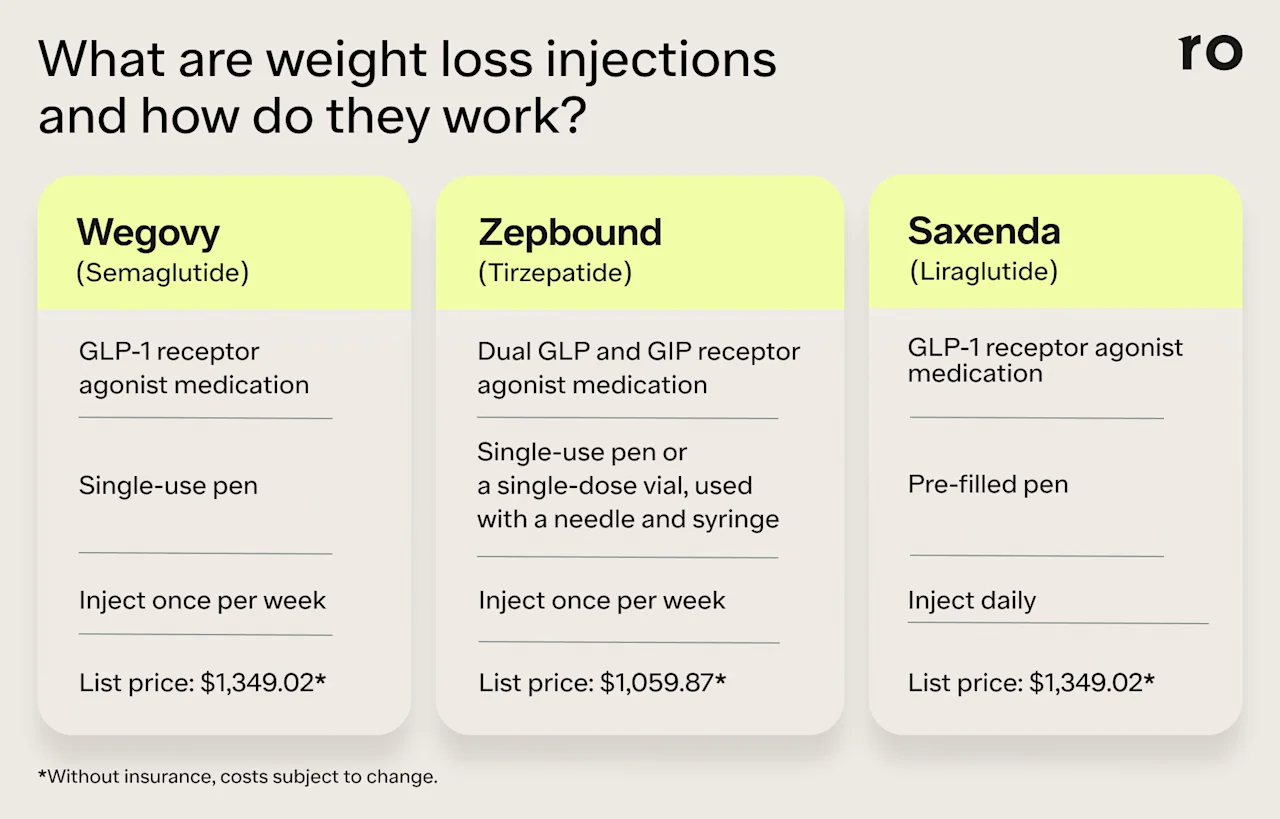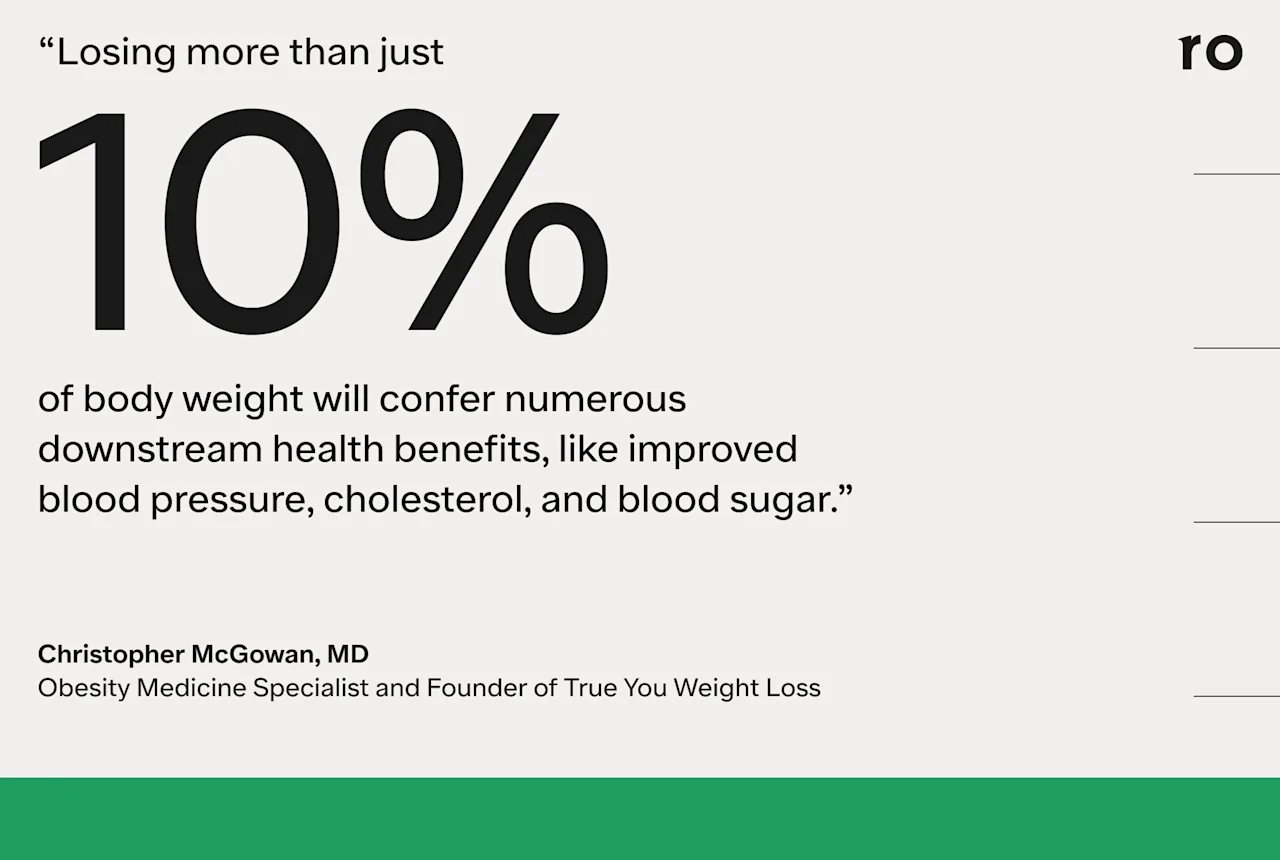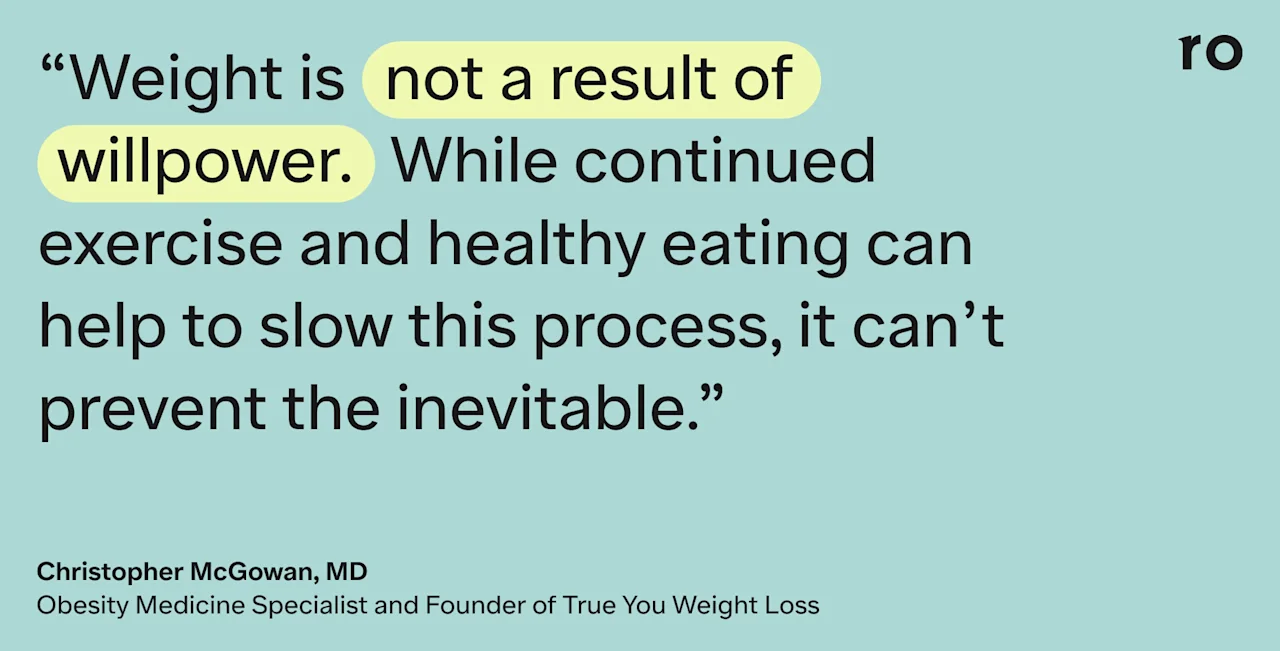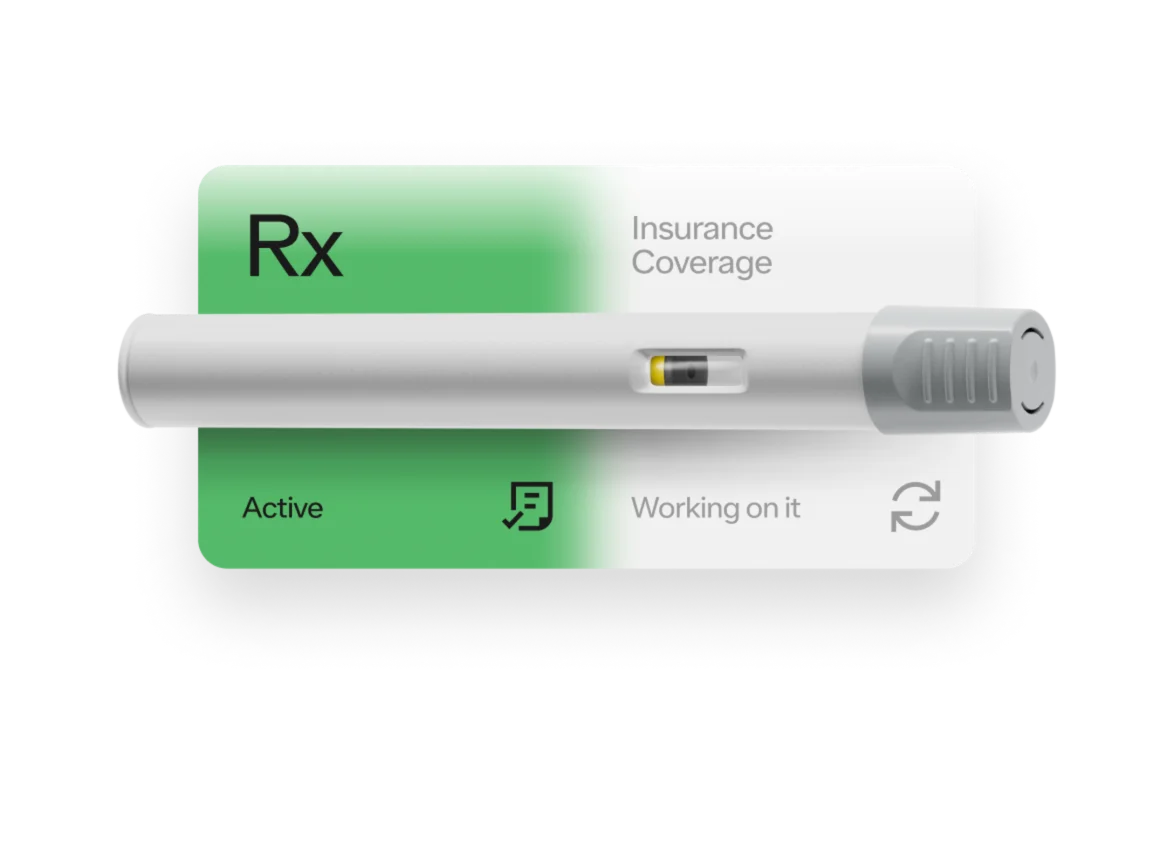Key takeaways
Weight loss injections such as semaglutide (Wegovy), liraglutide (Saxenda), and tirzepatide (Zepbound) work by mimicking a hormone that helps curb hunger and increase feelings of fullness after eating.
In clinical trials, these medications led to a 15 to 20% reduction in body weight when paired with a reduced-calorie diet and regular exercise.
Common side effects include nausea, diarrhea, and indigestion. Starting at the lowest dose and slowly increasing your dose may help minimize side effects.
It’s important to consult with a healthcare provider to determine if you are a good candidate for weight loss injections.
Here's what we'll cover
Here's what we'll cover
Here's what we'll cover
Key takeaways
Weight loss injections such as semaglutide (Wegovy), liraglutide (Saxenda), and tirzepatide (Zepbound) work by mimicking a hormone that helps curb hunger and increase feelings of fullness after eating.
In clinical trials, these medications led to a 15 to 20% reduction in body weight when paired with a reduced-calorie diet and regular exercise.
Common side effects include nausea, diarrhea, and indigestion. Starting at the lowest dose and slowly increasing your dose may help minimize side effects.
It’s important to consult with a healthcare provider to determine if you are a good candidate for weight loss injections.
Weight loss injections are part of a (relatively) new class of drugs called glucagon-like peptide-1 receptor agonists or GLP-1s. While many drugs in this class were initially approved to treat type 2 diabetes, they have also been approved for weight loss.
In addition to lowering blood sugar and promoting weight loss, GLP-1 medications have other potential health benefits, including lowering blood pressure and reducing heart disease risk.
At the same time, there are potential downsides with these medications, such as high cost, side effects, and questions about long-term use. These are all important factors to consider when talking to your healthcare provider about using these medications to lose weight.
Read on to learn more about injections for weight loss, how they work, side effects, the options available to you, and more.
What are injections for weight loss and how do they work?
Weight loss injections are a group of prescription medications called GLP-1 receptor agonists that you inject under the skin of your abdomen, thigh, or upper arm.
GLP-1 is a hormone in the body that stimulates the release of insulin after eating and helps lower blood sugar. It’s also an appetite hormone that slows down part of the digestive process and impacts the parts of your brain that control hunger and satiety, causing you to feel full faster. GLP-1 medications mimic the action of this natural hormone in the body.
There are several different GLP-1 medications currently approved for weight loss in people with obesity, including:
Liraglutide and semaglutide are GLP-1 receptor agonist medications, while tirzepatide is a dual GLP-1 and glucose-dependent insulinotropic polypeptide (GIP) receptor agonist medication. GIP may enhance the benefits of the GLP-1 medication.
Comparing popular weight loss drugs
Here’s a quick rundown of weight loss injections available in the U.S., along with details about their approved use, dosing information, and brand and generic names.

Wegovy (semaglutide)
Wegovy is a GLP-1 agonist medication that is approved to:
Aid in weight loss for adults and children over 12 years old who have obesity, or in adults who have overweight and have a weight-related health condition (such as high blood pressure, type 2 diabetes, or high cholesterol)
Reduce the risk of major cardiovascular events, such as heart attack or stroke, in adults who have cardiovascular disease and have obesity or overweight
Wegovy comes in a single-use pen that you inject once per week, either with or without food. With this medication, you have to take it on the same day each week. There are five different dose strengths: 0.25 mg, 0.5 mg, 1 mg, 1.7 mg, and 2.4 mg. Your healthcare provider will typically prescribe the lowest dose first and gradually increase it over time.
When prescribed to treat type 2 diabetes, this medication is called Ozempic. Ozempic is FDA-approved for blood sugar control in adults with type 2 diabetes. It is sometimes prescribed off-label for weight loss.
Zepbound (tirzepatide)
Zepbound is a dual GLP-1 and GIP receptor agonist medication. It is indicated for weight management for adults who:
Have obesity (BMI of 30 or above)
Have overweight (BMI of 27 or above) along with a weight-related comorbid condition like high blood pressure, dyslipidemia, type 2 diabetes, obstructive sleep apnea, or cardiovascular disease
Zepbound comes in either a single-use pen or a single-dose vial that you would use with a needle and syringe. It is taken once a week, on the same day each week, with or without food. Zepbound can be injected in the stomach, thigh, or back of the upper arm, and it is recommended to rotate injection sites each week.
Zepbound comes in different dosage amounts, ranging from 2.5 mg to 15 mg. People taking Zepbound start at the lowest dose and gradually increase it over time.
Tirzepatide may also be prescribed for type 2 diabetes under the brand name Mounjaro. Mounjaro is approved for blood sugar control in adults with type 2 diabetes, and like Ozempic, it may be prescribed off-label for weight loss.
Saxenda (liraglutide)
Saxenda is a GLP-1 medication appropriate for adults who:
Have obesity (BMI of 30 or above)
Have overweight (BMI of 27 or above) along with a weight-related comorbid condition like high blood pressure, type 2 diabetes, or high cholesterol or triglycerides
It is also approved for children ages 12 and above who weigh more than 132 pounds and are considered obese.
Saxenda is a daily medication. It can be injected at any time of day in the thigh, abdomen, or upper arm, and can be taken with or without food. It comes in a pre-filled pen that contains 3 mL of solution; to use this drug you will need to prepare a new needle and set the appropriate dosage on the pen for each use.
Saxenda has five dosage strengths: 0.6 mg, 1.2 mg, 1.8 mg, 2.4 mg, and 3 mg. People taking Saxenda start at 0.6 mg/day and typically increase their dose each week until they reach the maximum dosage of 3 mg daily.
How to inject a GLP-1 medication
If you are prescribed a GLP-1 for weight loss, you will need to learn how to self-inject the medication at home. Your provider can give you tips on the best way to administer the medication, and the drug manufacturers’ consumer websites typically have instructional videos and guides.
Be sure to read the instructions for your medication carefully, and reach out to your provider if you have any questions.
The instructions for Zepbound, Wegovy, and Saxenda all vary slightly, but these are the general injection steps for using and disposing of a medication pen:
Collect all supplies you need for the injection so that you have them within reach. That includes the GLP-1 pen, alcohol swab, gauze pad/cotton ball, and a sharps disposable container.
Wash your hands with warm water and soap, scrubbing for at least 20 seconds. Dry your hands thoroughly with a clean towel.
Check your pen to ensure that you have the correct dosage, the pen has not been damaged, the medicine appears clear in the pen window, and it has not expired.
Decide where you will inject the GLP-1. Options include the front of the thigh, lower stomach area (two inches away from your belly button), or upper arm. Change the injection spot each time to reduce skin irritation.
Use the alcohol swab or soap and water to clean your injection site.
Let your skin dry.
Get the pen ready: Remove the cap.
Push the pen firmly against your skin to administer the dose. Note: Each manufacturer has different instructions for how to administer an injection. Be sure to read the full instructions for use.
Once the medication has been dispensed, lift the pen off your skin. If there is a little blood, use gauze or cotton to apply light pressure to the area.
Dispose of the pen properly. Ideally, use an FDA-cleared sharps disposal container, otherwise dispose of the pen in a plastic container with a tight-fitting, puncture-resistant lid.
Be sure to read the instructions for more specific information on safe storage and handling, how/when to dispose of your used pens, and specific instructions for traveling with medication.
Are weight loss injections effective?
When combined with other lifestyle interventions, research shows that weight loss injections are effective for weight loss.

In one trial for semaglutide, participants taking a 2.4 mg once-weekly dose lost 14.9% of their body weight over 68 weeks compared to a weight reduction of 2.4% in the placebo group. In a trial on tirzepatide, a once-weekly 15 mg dose resulted in a 20.9% reduction in body weight over 72 weeks compared to a weight reduction of 3.1% in the placebo group.
In both trials, the treatment group paired medication with nutritional counseling, a reduced-calorie diet, and 150 minutes of exercise each week; the placebo group utilized lifestyle modifications alone.
“This degree of weight loss is far greater than what was seen with earlier-generation anti-obesity medications and is approaching procedural and surgical level results,” says Christopher McGowan, MD, obesity medicine specialist and founder of True You Weight Loss.
He adds that there are potential health benefits beyond the scale. “Losing more than just 10% of body weight will confer numerous downstream health benefits, like improved blood pressure, cholesterol, and blood sugar,” Dr. McGowan says.
He points to a clinical trial published in The New England Journal of Medicine studying the impact of semaglutide in people who were diagnosed with both overweight or obesity and heart disease, but who had no history of diabetes. Those taking 2.4 mg of semaglutide weekly had a lower risk of death from cardiovascular disease, nonfatal heart disease, and stroke compared to a placebo group over the 40 months of follow-up.
In this same trial, taking semaglutide was associated with reduced risk factors for cardiovascular disease, including blood pressure, waist circumference, lipids, and inflammatory markers.
How long do I have to take weight loss injections?
The exact length of time a person takes a GLP-1 medication will depend on several factors, including their weight loss goals, how well they tolerate the medication and their overall health status.
Most healthcare providers recommend staying on these medications for one to two years to maintain weight loss.

“People will have to be on these drugs long-term or the weight will come back on,” says Charlie Seltzer, MD, a board-certified obesity medicine doctor in Philadelphia.
Dr. McGowan adds that clinical trials for semaglutide also demonstrate this. “Patients regained roughly two-thirds of the weight they lost within one year of stopping the treatment. Over time, most patients will regain all the weight they lost, or more, after discontinuing treatment,” he says.
Dr. McGowan says this is likely due to genetic and physiological mechanisms driving excess weight, adding that when stopping these medications, people experience a rapid return of their hunger.
“Weight is not a result of willpower,” Dr. McGowan says. “While continued exercise and healthy eating can help to slow this process, it can’t prevent the inevitable.” He adds that some people say they feel even hungrier or overcome by stronger “food noise” than they experienced before starting weight loss medication.
If you are interested in GLP-1 medicine, keep in mind that this is designed as a long-term treatment.
Side effects and risks of weight loss injections
The most common side effects of GLP-1 medications include:
Nausea
Bloating
Diarrhea
Constipation
Vomiting
Loss of appetite
Other side effects may include dizziness, abdominal pain, headaches, indigestion, or injection site reactions such as pain, itching, or redness.
These side effects typically occur at the start of treatment and when switching to a higher dosage but tend to improve with time. If you’re concerned about side effects, talk to your provider about managing your dose, which includes starting at the lowest dose and increasing it slowly over time
“While side effects are a big concern for the GLP medications, most people find that side effects are manageable,” says Sarah Stombaugh, MD, a family medicine physician and a diplomate of the American Board of Obesity Medicine.
To help manage side effects, Dr. Stombaugh recommends eating small meals with each dose, staying hydrated, making sure you’re taking in electrolytes, and consuming protein shakes to ensure you’re getting some nutrition even if you don’t have much of an appetite.
She also recommends starting a fiber supplement at the same time with a GLP-1 to prevent constipation. If regularity continues to be a problem, your provider may advise taking a stool softener or laxative.
Warnings and precautions
Severe adverse effects are rare, but may include:
Acute (sudden) pancreatitis or inflammation of the pancreas, the organ that makes insulin and digestive juices
Increased heart rate
Gallbladder issues, such as inflammation or gallstones
Gastroparesis, a condition that affects the muscles and nerves in the stomach and slows down food digestion
Some populations may experience complications or risks with these medications. For example, in a clinical trial for Wegovy, 4% of adults who have type 2 diabetes and a BMI over 27 (considered overweight) developed diabetic retinopathy, a potential complication of diabetes that leads to blood vessel damage in the retina.
Although rare, an allergy to these medications is also possible. Trials on Zepbound found that 0.1% of patients had a severe hypersensitivity reaction (such as anaphylaxis) compared to 0% in the placebo group.
This is not an exhaustive list of all potential side effects or complications of these medications. If you’re considering medication for weight loss, the first and most important step you can take is to connect with a provider for a medical consultation to discuss these risks in detail.
During your consultation be sure to share as much information as possible about your unique health history, family history, current medications, and known health conditions and allergies to find out if you are a good candidate for these medications, or if there are any concerns regarding complications.
Ask how your health is monitored while on these injections, how to help minimize common side effects, and about warning signs or any symptoms that require immediate medical attention.
Safe use of weight loss injections
If your provider determines that you’re a good candidate for weight loss medication, they will have you start at the lowest dose, and then gradually increase your dose over time. Depending on the medication and how well you tolerate it, they may increase your dose each week or every four weeks. This approach can help your HCP monitor your progress and can also help to minimize potential side effects.
Eligibility and contraindications
Each of these medications comes with eligibility criteria, but these drugs are generally indicated for:
Adults who have obesity (BMI of 30 or above)
Adults who have overweight (BMI of 27 or above) as well as a weight-related comorbid condition, such as high blood pressure, type 2 diabetes, and obstructive sleep apnea
Some groups of people should not take these medications, including:
People who are pregnant
People with a personal or family history of medullary thyroid cancer
People who have a known serious hypersensitivity to the ingredients in the medication
Additionally, you should not use these medications in combination or with other weight loss medications.
There may be other reasons why these medications are not right for you, including if you have severe side effects or certain underlying health conditions. For some people, other treatments, including oral weight loss drugs, are a better option. That’s why it’s important to discuss your weight loss goal, personal and family medical history, and any side effects with your provider.
How much do weight loss injections cost?
Weight loss injections are expensive. Factors like insurance, coupons, and manufacturer savings cards can reduce that price.
Without insurance, Wegovy and Saxenda each cost $1,349.02 per month. However, if your insurance covers weight management medications, you may pay less than that. Some drug manufacturers also have special savings or cash payment options. For example, Zepbound has a self-pay option without insurance: $349 per month for the starting 2.5 mg dose. Once you increase to the higher 5 mg dose, you’ll pay $499 per month.
To know exactly how much you can expect to pay, contact your insurance company to discuss your benefits and eligibility requirements, and ask if you will need a prior authorization form. In some cases, insurance may fully cover weight loss medication, reducing your cost to $0.
Keep in mind that insurance coverage will vary by plan, and some plans may not cover these medications if they are being used off-label.
Tips for successful weight management with weight loss injections
While GLP-1s have been hyped as miracle cures, there is no magic wand for weight loss. These medications are designed to be paired with diet and exercise to achieve significant and sustainable weight loss.
In clinical trials, participants ate in a calorie deficit (consuming around 500 fewer calories per day) and exercised for about 150 minutes per week.
“Studies show that patients who use GLP medications alongside intensive lifestyle modifications have more significant weight loss compared to people who used medications alone,” says Dr. Stombaugh.
She advises people using weight loss drugs to eat a protein-rich diet and participate in regular physical activity, including resistance exercise. These two measures have been shown to help preserve muscle mass and strength in people with obesity during weight loss, per research in Nutrients.
Are weight loss injections safe?
Semaglutide, liraglutide, and tirzepatide are all FDA-approved medications for weight loss. This means they have been evaluated for safety and efficacy in clinical trials.
Whether or not they’re safe for you depends on your personal medical and family health history. These medications require a prescription, and it’s important to take them under the guidance of a medical provider.
For the best — and safest — results, you’ll want to discuss any current and past health conditions as well as your family health history to determine if your risk for using these medications outweighs its possible benefits.
Frequently asked questions (FAQs)
What are the best weight loss injections?
According to one clinical trial, when combined with a reduced-calorie diet and 150 minutes of weekly exercise, participants taking a once-weekly 15 mg dose of tirzepatide (Zepbound)saw a 20.9% reduction in body weight over 72 weeks compared to a 3.1% weight loss in a placebo group.
In another trial for semaglutide (Wegovy), participants who combined a once-weekly injection of 2.4 mg with diet and exercise saw a 14.9% reduction in body weight over 68 weeks compared to a loss of 2.4% body weight in the placebo group.
While these results are promising, it doesn’t mean that either of these specific medications is right for everyone. You and your provider can discuss your goals, plus risks and benefits, to determine what weight loss injection is best for you.
Which injection is the most cost-effective?
The answer to that depends on whether you’re using insurance and the details of your specific insurance coverage. Without insurance, Zepbound can cost as little as $399 per month at the lowest dose available. Wegovy and Saxenda both currently cost $1,349.02 per month without insurance.
Which brand is the easiest to inject?
Each of these medications can be injected into the abdomen, thigh, or back of the upper arm. However, you may want to consider how often you need to inject them when deciding which one is “easiest.”
Saxenda (liraglutide) is a once-daily injection and uses a pre-filled pen that requires you to adjust the dosage and prepare a new needle each time. Wegovy and Zepbound are both injected weekly using a single-use pen that is discarded after each use. Zepbound also comes in a single-use vial that you inject with a needle and syringe.
For each medication, you can administer the injections yourself if you are injecting into the abdomen or thigh. You will need help from another person if you inject the medication into your upper arm.
What is better: weight loss with Ozempic or Wegovy?
Both medications are injectable semaglutide, but they have different brand names and FDA indications. Wegovy is indicated for weight loss, while Ozempic is indicated to treat diabetes (though it is sometimes used off-label for weight loss). Talk to your provider about which one is best for you based on your goals and health history. It’s important to note that most insurance companies will not cover the cost of off-label drugs.
Do weight loss injections work?
Yes. Clinical trials show that people can lose upwards of 15 to 20% of their starting body weight with long-term use, and when combined with dietary changes and regular exercise.
Are weight loss injections safe?
Weight loss injections such as Wegovy, Saxenda, and Zepbound are FDA-approved medications. Clinical trials show that they are effective and safe.
Bottom line
GLP-1 receptor agonist medications such as Wegovy, Saxenda, and Zepbound are FDA-approved for weight loss.
This class of drugs mimics the effects of the GLP-1 hormone, which helps to curb appetite, lower blood sugar, and help you feel full faster.
In addition to weight loss and blood sugar control, these medications may also decrease cardiovascular risks in certain groups of people.
When paired with a reduced-calorie diet and regular exercise, research shows that these medications are effective for weight loss – clinical trial participants reported a 15-20% reduction in body weight.
These drugs are meant to be taken long-term, and stopping them too soon may result in rebound weight gain.
The most common side effects include diarrhea, nausea, and constipation. Severe side effects are rare, but you should always speak with a provider to understand your risk.
Talk to a knowledgeable healthcare provider to determine if these medications are right for you, and if so, which one is best suited to your health needs and weight loss goals. They can also provide guidance on managing common side effects and change the dose or type of medication if needed.
DISCLAIMER
If you have any medical questions or concerns, please talk to your healthcare provider. The articles on Health Guide are underpinned by peer-reviewed research and information drawn from medical societies and governmental agencies. However, they are not a substitute for professional medical advice, diagnosis, or treatment.
GLP-1 Important Safety Information: Read more about serious warnings and safety info.
Saxenda Important Safety Information: Read more about serious warnings and safety info.
Wegovy Important Safety Information: Read more about serious warnings and safety info.
Zepbound Important Safety Information: Read more about serious warnings and safety info.
Ozempic Important Safety Information: Read more about serious warnings and safety info.
References
Cava, E., Yeat, N. C., & Mittendorfer, B. (2017). Preserving Healthy Muscle during Weight Loss. Advances in Nutrition (Bethesda, Md.), 8(3), 511–519. doi: 10.3945/an.116.014506. Retrieved from https://pmc.ncbi.nlm.nih.gov/articles/PMC5421125/
Collins, L. & Costello, R. A. (2024). Glucagon-Like Peptide-1 Receptor Agonists. StatPearls. Retrieved Nov. 1, 2024 from https://www.ncbi.nlm.nih.gov/books/NBK551568/
Farzam, K. & Patel, P. (2024). Tirzepatide. StatPearls. Retrieved Nov. 1, 2024 from https://www.ncbi.nlm.nih.gov/books/NBK585056/
Filippatos, T. D., Panagiotopoulou, T. V., & Elisaf, M. S. (2014). Adverse Effects of GLP-1 Receptor Agonists. The Review of Diabetic Studies : RDS, 11(3-4), 202–230. doi: 10.1900/RDS.2014.11.202. Retrieved from https://pmc.ncbi.nlm.nih.gov/articles/PMC5397288/
Kraftson, A., & Griauzde, D. (2024). What Should I Know About Injectable Weight-Loss Medications?. JAMA Internal Medicine, 184(7), 854. doi: 10.1001/jamainternmed.2023.7268. Retrieved from https://pubmed.ncbi.nlm.nih.gov/38466303/
Jastreboff, A. M., Aronne, L. J., Ahmad, N. N., et al. (2022). Tirzepatide Once Weekly for the Treatment of Obesity. The New England Journal of Medicine, 387(3), 205–216. doi: 10.1056/NEJMoa2206038. Retrieved from https://pubmed.ncbi.nlm.nih.gov/35658024/
Lilly-a. (2024). How Zepbound Works. Lilly USA. Retrieved from https://zepbound.lilly.com/hcp/how-zepbound-works
Lilly-b. (2024). Savings options for Zepbound–regardless of insurance status. Lilly USA. Retrieved from https://zepbound.lilly.com/coverage-savings
Lilly-c. (2024). Zepbound Highlights of Prescribing Information. Lilly USA. Retrieved from https://pi.lilly.com/us/zepbound-uspi.pdf?s=pi
Lincoff, A. M., Brown-Frandsen, K., Colhoun, H. M., et al. (2023). Semaglutide and Cardiovascular Outcomes in Obesity without Diabetes. The New England Journal of Medicine, 389(24), 2221–2232. doi: 10.1056/NEJMoa2307563. Retrieved from https://pubmed.ncbi.nlm.nih.gov/37952131/
NovoCare-a. (2024). What is the list price for Saxenda and will it impact me? Novo Nordisk. Retrieved from https://www.novocare.com/obesity/products/saxenda/explaining-list-price.html
NovoCare-b. (2024). What is the list price for Wegovy and will it impact me? Novo Nordisk. Retrieved from https://www.novocare.com/obesity/products/wegovy/let-us-help/explaining-list-price.html
Novo Nordisk-a. (2023). Ozempic Highlights of Prescribing Information. Novo Nordisk. Retrieved from https://www.novo-pi.com/ozempic.pdf
Novo Nordisk-b. (2023). Saxenda Highlights of Prescribing Information. Novo Nordisk. Retrieved from https://www.novo-pi.com/saxenda.pdf
Novo Nordisk. (2024). Wegovy Highlights of Prescribing Information. Novo Nordisk. Retrieved from https://www.novo-pi.com/wegovy.pdf
US Food and Drug Administration (FDA). (2024). Human Drug Compounding. Retrieved from https://www.fda.gov/drugs/guidance-compliance-regulatory-information/human-drug-compounding
van Bloemendaal, L., Ten Kulve, J. S., la Fleur, S. E., et al. (2014). Effects of glucagon-like peptide 1 on appetite and body weight: focus on the CNS. The Journal of Endocrinology, 221(1), T1–T16. doi: 10.1530/JOE-13-0414. Retrieved from https://pubmed.ncbi.nlm.nih.gov/24323912/
Wilding, J. P. H., Batterham, R. L., Calanna, S., et al. (2021). Once-Weekly Semaglutide in Adults with Overweight or Obesity. The New England Journal of Medicine, 384(11), 989–1002. doi: 10.1056/NEJMoa2032183. Retrieved from https://pubmed.ncbi.nlm.nih.gov/33567185/
Wilding, J. P. H., Batterham, R. L., Davies, M., et al. (2022). Weight regain and cardiometabolic effects after withdrawal of semaglutide: The STEP 1 trial extension. Diabetes, Obesity & Metabolism, 24(8), 1553–1564. doi: 10.1111/dom.14725. Retrieved from https://pmc.ncbi.nlm.nih.gov/articles/PMC9542252/













